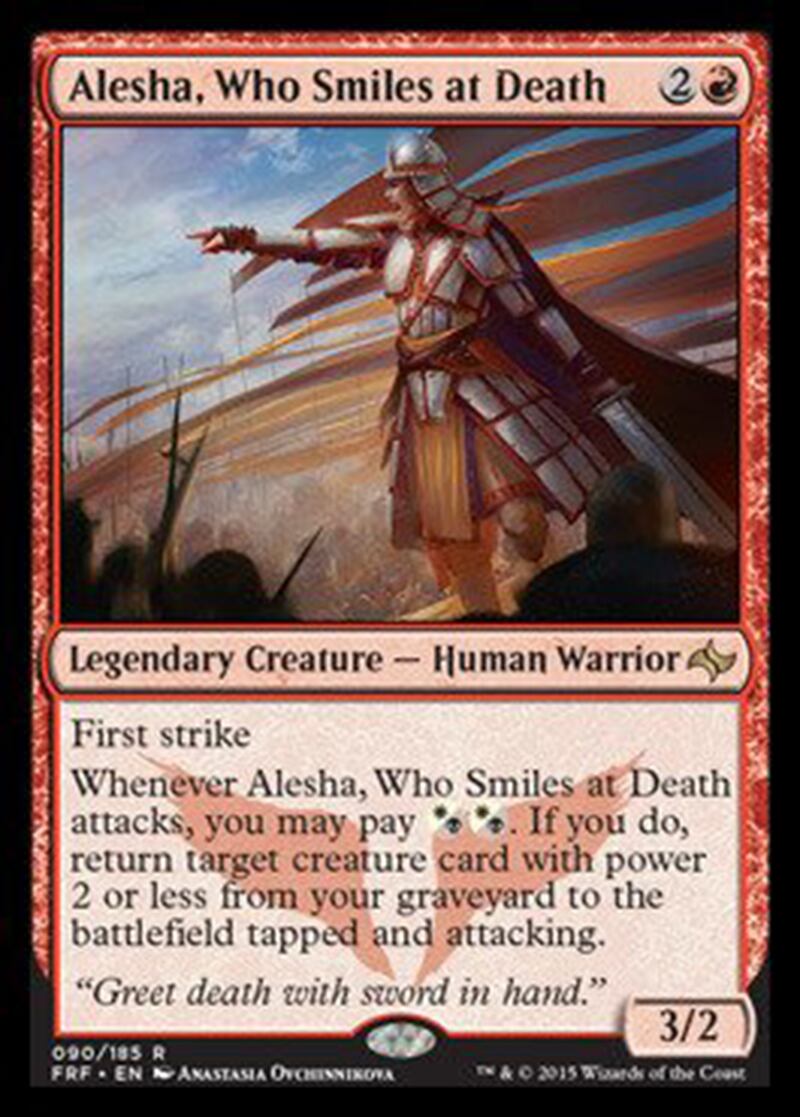Earlier this year, the 20-year-old card game Magic: The Gathering introduced its first openly trans character. It was a groundbreaking moment in the storied gaming franchise, but one we must remember, on International Trans Visibility Day, was a long time coming.
Her name is “Alesha, Who Smiles at Death,” a khan of the Mardu. The story “The Truth of Names” by James Wyatt, Matt Knicl, and Allison Medwin introduces some of the character’s backstory during a fight with six dragons and how at least one member of her group, a male orc, uses Alesha’s gender identification to challenge her leadership.
The story is a high fantasy parable, with Alesha both battling dragons and observing the actions of an Orc who is part of the Mardu fighting party. Wyatt presents the Mardu as a battle oriented society and the group’s fighters have “bold, grisly names” describing their actions in combat: “Headsmasher. Skullcleaver. Wingbreaker.”
As the Mardu face off against the dragons, Alesha witnesses a nameless, undistingsuished Orc who lets another fighter take a stab at the dragon that was theirs to make. Alesha scolds him for it and, stung by a commander’s criticism, the Orc challenges her authority to give instructions saying: “‘You tell me this? A human boy who thinks he's a woman?’.”

Later, when the dragons have been killed, Alesha acknowledges the Orc’s assistance to other warriors in ways not recognized by the Mardu’s attack-centric nomenclature and uses its importance to assert her female identity. Alesha says to the assembled horde: “I know who I am. I am not a boy. I am Alesha, like my grandmother before me.”
The art for Wyatt’s story, and the card on which Alesha appears, was created by Montreal based artist Anastasia Ovchinnikova. The artist has developed several other cards for Magic: The Gathering, one for the Fate Reforged expansion in which Alesha appears, and two in the original Khans of Tarkir expansion.
Ovchinnikova, who has a Bachelor’s degree in art and drawing, spent several years working as a concept artist for different companies before joining WotC. “But all that time I was dreaming of working on Magic the Gathering.” Ovchinnikova said in an interview with The Daily Beast. “Finally one day I received an email from Jeremy Jarvis (art director) who offered me my first illustration commission.”
Ovchinnikova started her career trying to be an interior designer, but she found the job “a bit boring.” It was her husband who introduced her to the world of computer gaming.
“Before I got involved with the creation of Alesha, I had already finished my first Abzan human noble ‘Zealous Strike.’” Ovchinnikova said. “It is always exciting to work on a strong character and I put a ton of work to find the right pose and lighting. I love to work on details and at the same time I always trying to keep my illustrations clean and easy-to-read. While I was working on [the] illustration of Alesha the hardest part for me was to create an imposing and powerful pose.”
Alesha also occupies a unique place in Wizards of the Coast art because her femininity is self-proclaimed rather than derived from a more overtly feminized outfit. Wizards has been the target of criticism because of the revealing costumes in which its female characters often appear, although they are far from the only content producer in the High Fantasy genre with female presenting characters dressed in impractical and sexualized ways.
The backstory for Alesha appeared on the Wizards of the Coast Uncharted Realms site, a weekly online publication for Magic: The Gathering fiction. It is one of three pieces of short fiction by Wyatt for the site, but the author has worked in high fantasy since the 1990s when, as a United Methodist minister, he began submitting material to Dragon magazine and TSR, Inc., the company Gary Gygax and Dave Arneson created to self-publish the original Dungeons and Dragons. Since 2000, Wyatt has worked for WotC.
Wyatt’s earliest work for Wizards on the company’s Forgotten Realms product line may explain the inclusion of a trans character in the new Magic cards. One of the most prominent characters in the Forgotten Realms universe is the mage Elminster, who was turned into a woman by the Faerûnian goddess Mystra so he could learn magic and appreciate life as a woman. Although Elminster eventually turned back into a man, he would be magically powerless without his temporary access to a female identity.
But Alesha also highlights the ongoing struggle to maintain visibility for queer characters in openly hostile High Fantasy media. Trans characters in fiction stretch back to antiquity with gender queer representations in diverse works such as the Christian Bible’s Holy Spirit, Hesiod’s blind seer Tiresias, and Shikhandi from the Mahabharata.
Conservatism appeals to history because it aims to recreate in the present a past that never existed. Far from being a product with a long and storied tradition, the modern family—and its perverted “values”—is an aberration.
The past is queer.
As gaming activist and writer Katherine Cross told Bitch Magazine last December: “[W]omen, people of color, and queer gamers have always been a part of the gaming world at every level.”
The act of trans erasure, especially in high fantasy, is an ongoing process. The “fathers” of modern fantasy, J.R.R. Tolkien, Robert E. Howard, and H.P. Lovecraft sidelined the female heroes that once shared equal space with men. And yet, even Tolkien made the wizard Gandalf a genderless spirit called a Maiar who only presents as male.
But the fact remains that to learn Gandalf is a maiar (and that there are female Orcs), one must dig deep into Lord of the Rings apocrypha, an expensive proposition for casual fans in a culture where white, cis, straight, male workers’ ability to outearn their Women, Trans, and Queer colleagues is evidence of “marketability” and not exclusion.
For anyone with a computer and the inclination to learn more about Magic: The Gathering, Alesha’s story is free.



